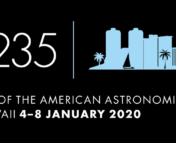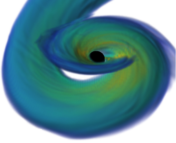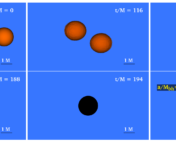In this series of posts, we sit down with a few of the keynote speakers of the 235th AAS meeting to learn more about them and their research. You can see a full schedule of their talks here!
The Merger of Theory and Observation
On August 17, 2017, gravitational waves from two merging neutron stars were detected for the first time. Remarkably, this event (known as a kilonova) was also detected in the electromagnetic spectrum shortly after. This kilonova ushered in the era of ‘multi-messenger’ astrophysics with gravitational waves, when both gravitational waves and electromagnetic emission can be used to study astronomical phenomena.
For Professor Daniel Kasen, though, this was confirmation of years of work simulating and predicting what observations of such an event would look like. When two neutron stars merge, heavy elements are produced through a mechanism known as the r-process. These heavy elements are unstable, though, and their radioactive decay produces the light that we call the kilonova. While there is still much work to do on modeling the properties of kilonovae, there was remarkable agreement between his theoretical predictions and the first observations. For this work, Kasen is one of this year’s awardees of the Bruno Rossi Prize, along with his collaborator Professor Brian Metzger of Columbia University.
An Explosive Career
Upon entering graduate school at Berkeley, Kasen was fascinated with cosmology. He found the recent work that used Type Ia supernovae to show that the expansion of the universe was accelerating to be very engaging, but he realized that the cosmology side was quickly becoming crowded. “As time went on, I just wound up drifting a little bit more from the cosmology to trying to understand the supernovae themselves and trying to do some modeling of those,” he says. “There seemed to be a gap there. There’s a lot of people trying to model the explosion itself and a lot of people trying to do observations of the supernova, but not many people trying to make predictions of what we could see based on radiation transport.”
From there, Kasen branched out into modeling different types of supernovae and “any kind of astrophysical event where you can model the radiation and interpret the spectrum or light curves.” Wide-field surveys have revolutionized this area of astronomy known as ‘transients’, as they are able to scan huge areas of the sky and pick out large numbers of interesting events. These have provided very rich datasets for theorists to play with, but there have also been many more mysteries raised by irregular objects that don’t fit the models. “There’s a lot of questions still to address,” Kasen says. “I go back and forth on where the most interesting science is going to come out…There’s a lot of different phenomenon to think about, and so it’s tough to figure out what is the most interesting or promising among those.”
The kilonova is one of the phenomena that Kasen knew was interesting from the start. Using his expertise in radiation transport, he made early predictions about what light curves from a kilonova would look like and how heavy elements could be formed in the explosion that resulted from the merger. Figure 1 shows a comparison of Kasen’s light curve predictions with the observations of the kilonova. “It happened a lot sooner than I ever expected,” he said. “I thought we would be chasing the events for 5, 10 years before we got something like this. So we got quite lucky that we had an event happen so nearby and that observers were able to get onto it and get the data.”
Supernovae on Supercomputers
Nowadays, much of the theoretical work in astrophysics happens on the computer. While some of Kasen’s models are developed with pen and paper, other calculations can take months to run on a supercomputer. In Kasen’s view, developing a big code in astrophysics has become like building an instrument: a team must develop, maintain, and upgrade it in order to be useful to the community. He is involved with projects funded by the U.S. Department of Energy to prepare for the next generation of exascale computing, which will require new ways of thinking about big codes.
As he says, “These machines are getting complicated and the architectures are getting complicated, so you need to be clever and write your codes to actually make use of that computing power.” Nevertheless, he continues to build his own codes and believes there is still a lot of room to write simulation code yourself that is scientifically useful, as long as you strike a balance between code development and scientific insight.
Establishing a Research Identity
While it is important to establish yourself as an expert in a particular field, Kasen cautions against restricting your view, especially in graduate school. “I would encourage people to look at whatever seems rewarding to them,” he says. Throughout his career, he has worked on a myriad of different topics, allowing his curiosity to guide him.
This intellectual freedom has served him well, and he credits his transition to an independent researcher in graduate school as a major turning point for him. “I’d say I spent a good portion of my early graduate career kind of wandering the desert trying to figure out what I was doing, you know, not really sure how to make progress,” he says. “I guess one of the realizations I had that is somewhat obvious in retrospect is that no one is going to do this for me. No one is going to just sit down and say here is what you have to do…Where I really started making progress on my research is where I kind of just said, ‘Look, I just want the opportunity to do something interesting’. I’m sort of going to forget about all of the distractions and just try to address some interesting questions I have in research. And then I’ll see where that leads me.”
Come check out Professor Kasen’s talk on “Kilonovae from Merging Neutron Stars” (with Prof. Brian Metzger) on Monday, January 6th at 4:40 PM at #AAS235!




